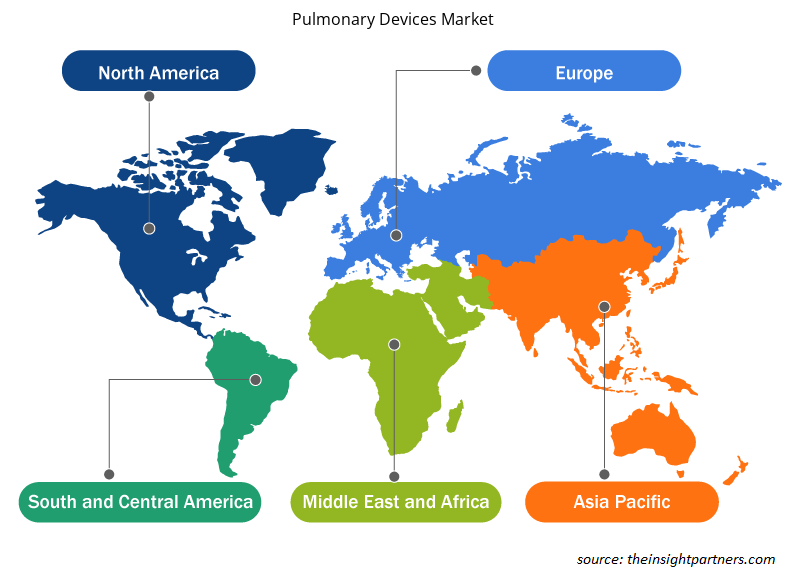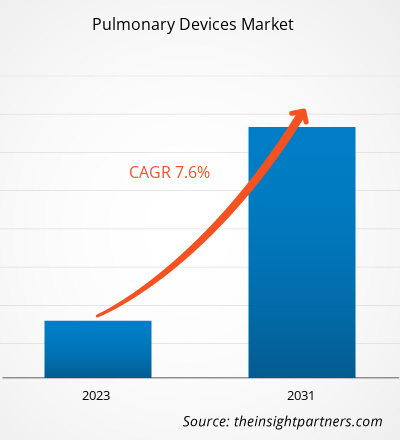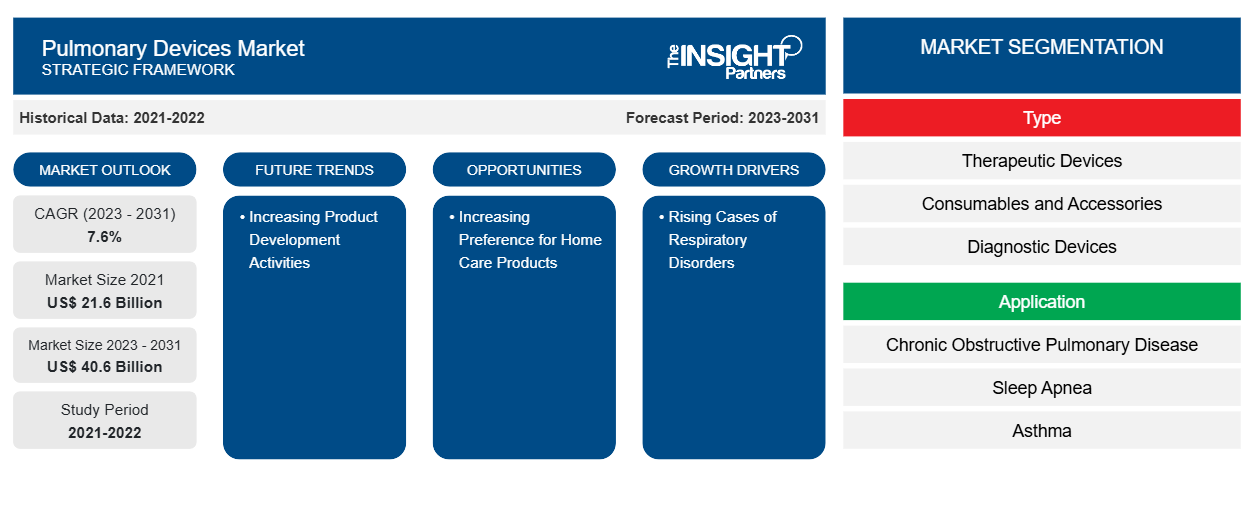Se estimó que el tamaño del mercado de dispositivos pulmonares sería de 21.600 millones de dólares en 2021 y de XX mil millones de dólares en 2023, y se espera que alcance los 40.600 millones de dólares en 2031; se estima que registrará una CAGR del 7,6% en 2023-2031. El aumento de casos de trastornos respiratorios y las iniciativas estratégicas de las empresas son factores impulsores. La creciente preferencia por los productos de cuidado del hogar probablemente seguirá siendo clave para las tendencias del mercado de dispositivos pulmonares.
Análisis del mercado de dispositivos pulmonares
Las enfermedades pulmonares se encuentran entre las afecciones médicas más comunes en todo el mundo. Millones de personas en todo el mundo padecen diversos tipos de enfermedades respiratorias y los factores más comunes responsables de las mismas son el tabaquismo, los factores genéticos y las infecciones. Afecciones médicas como el asma y la enfermedad pulmonar obstructiva crónica (EPOC), la bronquitis crónica, la fibrosis quística y el cáncer de pulmón se encuentran entre las cargas significativas para la salud pública. Según la Organización Mundial de la Salud (OMS), a nivel mundial, la EPOC es la séptima causa principal de mala salud. Por lo tanto, los fabricantes del mercado de dispositivos pulmonares están intensificando su enfoque en la adopción de diversas estrategias, como la innovación de productos, los lanzamientos de productos y las aprobaciones, para mantener un entorno competitivo en el mercado. Por ejemplo, en la India, Lupin Limited lanzó Vilfuro-G, un fármaco de combinación triple de dosis fija para el tratamiento de la enfermedad pulmonar obstructiva crónica (EPOC).
Descripción general del mercado de dispositivos pulmonares
La región de Asia y el Pacífico es el mercado de dispositivos pulmonares que crece más rápidamente. El crecimiento se debe principalmente a la mayor prevalencia de enfermedades respiratorias y cardíacas que requieren atención hospitalaria y al aumento de las actividades de investigación. China es uno de los países más poblados del mundo y es el país con mayor número de pacientes que padecen trastornos respiratorios y cardíacos.
Personalice este informe según sus necesidades
Obtendrá personalización en cualquier informe, sin cargo, incluidas partes de este informe o análisis a nivel de país, paquete de datos de Excel, así como también grandes ofertas y descuentos para empresas emergentes y universidades.
-
Obtenga las principales tendencias clave del mercado de este informe.Esta muestra GRATUITA incluirá análisis de datos, desde tendencias del mercado hasta estimaciones y pronósticos.
Impulsores y oportunidades del mercado de dispositivos pulmonares
Aumento de casos de trastornos respiratorios
La prevalencia del asma, la fibrosis quística, la enfermedad pulmonar obstructiva crónica (EPOC) y otras enfermedades respiratorias está aumentando en todo el mundo. Por ejemplo, el asma contribuye al 1% de todas las muertes en la mayoría de los países del mundo. Además, una de las principales causas de enfermedades respiratorias como la EPOC y el asma es el aumento de la contaminación del aire.COPD), and other respiratory diseases is increasing across the globe. For example, Asthma contributes to 1% of all deaths in most countries worldwide. In addition, one of the major causes of respiratory diseases such as COPD and asthma is the rise in air pollution.
Aumentar las actividades de desarrollo de productos: una oportunidad
El creciente número de aprobaciones y desarrollos de productos fortalecerá la demanda de dispositivos pulmonares en los próximos años. Por ejemplo, la empresa emergente de dispositivos médicos Circadia Health recibió la aprobación de la FDA en junio de 2020 para un dispositivo Circadia C100 impulsado por IA. Este dispositivo se coloca junto a la cama y permite un monitoreo continuo, remoto y de grado médico de la respiración. Además, en febrero de 2024, Pulmonx inicia el estudio CONVERT II del sistema AeriSeal en pacientes con EPOC.Circadia Health received FDA approval in June 2020 for an AI-powered Circadia C100 device. This device is placed at the bedside and allows for continuous, remote, medical-grade monitoring of their breathing. Furthermore, in February 2024, Pulmonx initiates the CONVERT II study of the AeriSeal System in COPD patients.
La adopción de dispositivos pulmonares ha aumentado significativamente en varios países de América del Norte, Europa y Asia.
Análisis de segmentación del informe de mercado de dispositivos pulmonares
Los segmentos clave que contribuyeron a la derivación del análisis del mercado de dispositivos pulmonares son el tipo, la aplicación y el usuario final.
- Según el tipo, el mercado de dispositivos pulmonares se segmenta en consumibles y accesorios, dispositivos terapéuticos, dispositivos de diagnóstico y dispositivos de monitorización. En 2023, el segmento de dispositivos terapéuticos tuvo la mayor participación del mercado. Sin embargo, se espera que el segmento de consumibles y accesorios crezca al ritmo más rápido durante el período de pronóstico.
- Según la aplicación, el mercado de dispositivos pulmonares se segmenta en asma, EPOC, apnea del sueño , enfermedades infecciosas y otras. El segmento de EPOC tuvo la mayor participación en el mercado de dispositivos pulmonares en 2023. Además, se prevé que el mismo segmento experimente un crecimiento a un ritmo significativo durante el período de pronóstico.
- Según el usuario final, el mercado de dispositivos pulmonares se segmenta en hospitales, centros de atención domiciliaria y centros de atención ambulatoria. En 2023, el segmento de hospitales tuvo la mayor participación del mercado. Sin embargo, se espera que el segmento de centros de atención domiciliaria crezca al ritmo más rápido durante el período de pronóstico.
Análisis de la cuota de mercado de dispositivos pulmonares por geografía
El alcance geográfico del informe de mercado de dispositivos pulmonares se divide principalmente en cinco regiones: América del Norte, Asia Pacífico, Europa, Medio Oriente y África, y América del Sur/América del Sur y Central.
El mercado de dispositivos pulmonares de América del Norte está segmentado en Estados Unidos, Canadá y México. Estados Unidos tuvo la mayor participación en el mercado de dispositivos pulmonares de América del Norte en 2023. El crecimiento proyectado del mercado de dispositivos pulmonares en América del Norte se atribuye a factores como la presencia de actores líderes del mercado y el desarrollo de sus productos, la creciente población geriátrica y la creciente prevalencia de enfermedades e infecciones pulmonares. Por ejemplo, la empresa ChestPal, con sede en el Reino Unido, lanzó su nuevo estetoscopio digital, ChestPal Pro, para profesionales de la salud en Estados Unidos. Este dispositivo ofrece detección y clasificación automáticas de crepitaciones y sibilancias, diseñado para ayudar a los médicos a realizar diagnósticos precisos y rápidos, lo que podría reducir las visitas a urgencias por afecciones respiratorias.
Perspectivas regionales del mercado de dispositivos pulmonares
Los analistas de Insight Partners explicaron en detalle las tendencias y los factores regionales que influyen en el mercado de dispositivos pulmonares durante el período de pronóstico. Esta sección también analiza los segmentos y la geografía del mercado de dispositivos pulmonares en América del Norte, Europa, Asia Pacífico, Oriente Medio y África, y América del Sur y Central.

- Obtenga datos regionales específicos para el mercado de dispositivos pulmonares
Alcance del informe de mercado de dispositivos pulmonares
| Atributo del informe | Detalles |
|---|---|
| Tamaño del mercado en 2021 | US$ 21.6 mil millones |
| Tamaño del mercado en 2031 | US$ 40.6 mil millones |
| CAGR global (2023 - 2031) | 7,6% |
| Datos históricos | 2021-2022 |
| Período de pronóstico | 2023-2031 |
| Segmentos cubiertos |
Por tipo
|
| Regiones y países cubiertos |
América del norte
|
| Líderes del mercado y perfiles de empresas clave |
|
Densidad de actores del mercado de dispositivos pulmonares: comprensión de su impacto en la dinámica empresarial
El mercado de dispositivos pulmonares está creciendo rápidamente, impulsado por la creciente demanda de los usuarios finales debido a factores como la evolución de las preferencias de los consumidores, los avances tecnológicos y una mayor conciencia de los beneficios del producto. A medida que aumenta la demanda, las empresas amplían sus ofertas, innovan para satisfacer las necesidades de los consumidores y aprovechan las tendencias emergentes, lo que impulsa aún más el crecimiento del mercado.
La densidad de actores del mercado se refiere a la distribución de las empresas o firmas que operan dentro de un mercado o industria en particular. Indica cuántos competidores (actores del mercado) están presentes en un espacio de mercado determinado en relación con su tamaño o valor total de mercado.
Las principales empresas que operan en el mercado de dispositivos pulmonares son:
- Philips NV, la línea Koninklijke
- Caire Inc. (Industrias Chart)
- Inogen Inc.
- Corporación Invacare
- Conceptos de O2
- Tipos médicos de Nidek, Inc.
Descargo de responsabilidad : Las empresas enumeradas anteriormente no están clasificadas en ningún orden particular.

- Obtenga una descripción general de los principales actores clave del mercado de dispositivos pulmonares
Noticias y desarrollos recientes del mercado de dispositivos pulmonares
El mercado de dispositivos pulmonares se evalúa mediante la recopilación de datos cualitativos y cuantitativos de investigaciones primarias y secundarias, que incluyen publicaciones corporativas importantes, datos de asociaciones y bases de datos. A continuación, se incluye una lista de los avances en el mercado de dispositivos pulmonares:
- Vitalograph, desarrollador de dispositivos de diagnóstico respiratorio, lanzó su serie de pruebas de función pulmonar VitaloPFT, destinada a su uso en atención secundaria. Esta nueva serie proporciona soluciones avanzadas de diagnóstico respiratorio a unidades de atención primaria y secundaria que exigen pruebas complejas de la función pulmonar. (Fuente: Serum Institute of India (Vitalograph/Comunicado de prensa, marzo de 2023)
- Xplore Health Technologies lanzó un dispositivo de entrenamiento de los músculos respiratorios (RMT) único en su tipo, Airofit Pro. El producto surge en colaboración con Airofit, Dinamarca. Es el primer sistema de entrenamiento respiratorio inteligente basado en datos personales del mundo con un precio de 34.990 rupias. El dispositivo puede entrenar los músculos inspiratorios y espiratorios, otra característica única. (Fuente: Reveal Lasers, comunicado de prensa, octubre de 2023)
Informe sobre el mercado de dispositivos pulmonares: cobertura y resultados
El informe “Tamaño y pronóstico del mercado de dispositivos pulmonares (2021-2031)” proporciona un análisis detallado del mercado que cubre las siguientes áreas:
- Tamaño del mercado y pronóstico a nivel global, regional y nacional para todos los segmentos clave del mercado cubiertos bajo el alcance
- Dinámica del mercado, como impulsores, restricciones y oportunidades clave
- Principales tendencias futuras
- Análisis detallado de las cinco fuerzas de Porter y PEST y FODA
- Análisis del mercado global y regional que cubre las tendencias clave del mercado, los principales actores, las regulaciones y los desarrollos recientes del mercado.
- Análisis del panorama de la industria y de la competencia que abarca la concentración del mercado, el análisis de mapas de calor, los actores destacados y los desarrollos recientes
- Perfiles detallados de empresas
- Análisis histórico (2 años), año base, pronóstico (7 años) con CAGR
- Análisis PEST y FODA
- Tamaño del mercado, valor/volumen: global, regional y nacional
- Industria y panorama competitivo
- Conjunto de datos de Excel
Informes recientes
Testimonios
Razón para comprar
- Toma de decisiones informada
- Comprensión de la dinámica del mercado
- Análisis competitivo
- Información sobre clientes
- Pronósticos del mercado
- Mitigación de riesgos
- Planificación estratégica
- Justificación de la inversión
- Identificación de mercados emergentes
- Mejora de las estrategias de marketing
- Impulso de la eficiencia operativa
- Alineación con las tendencias regulatorias























 Obtenga una muestra gratuita para - Mercado de dispositivos pulmonares
Obtenga una muestra gratuita para - Mercado de dispositivos pulmonares